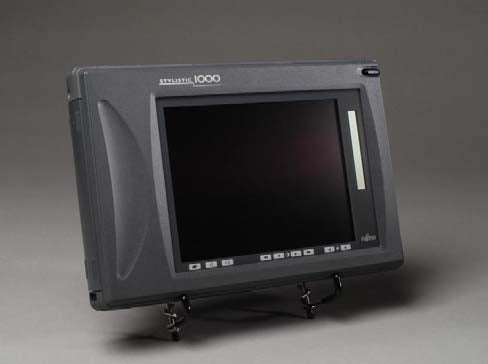You've surely noticed that the popularity of tablet computers has skyrocketed over the past few years – it's like everybody, from toddlers to grandmas, now has one. Things were quite a bit different during the dark ages of tablet computing, however. The very first tablets were extremely expensive, very limited in features, huge and heavy by today's standards, and not particularly fun to use. In fact, the vintage tablet computers that we're about to introduce you to would make even a first-gen iPad look like space-age technology.
The GRiDPad tablet, released in 1989
Here's one piece of tablet history – the GRiDPad. Released on the market in 1989, it was one of the very first tablet computers that an average Joe could actually buy. Its weight of 4.5 pounds (over 2 kg) and thickness of 1.4 inches (3.6 cm) put this beast nowhere near an iPad Air, but for its time, the device was considered to be quite compact. Specs included a 10MHz 80C86 processor, 1MB of RAM, a 10-inch monochrome screen with 640 by 400 pixels of resolution, 256- or 512-kilobyte removable storage cards, and, wait for it, a 2400 baud modem – that's about 2.4 kilobits per second for you, kids. Optionally, you could get a 20MB hard disk drive, as long as you didn't mind the 3 pounds (1.36 kg) of extra bulk. The tablet ran a version of DOS 3.3 modified so that it could recognize touch and handwriting inputs. All of this goodness could be yours for as low as $2370, or $3000 including the software. Some 10 000 GRiDPad units were sold in 1990, according to its maker. Of course, there was no Netflix, no Spotify, and no Call of Duty 4 back in 1989; the hardware specs of the GRiDPad were sufficient for the software that it was made to run. It is said that Chrysler and the US Army were using these for inventory purposes as the pen-based input made them suitable for the job. Units used by the army were made of sturdy magnesium instead of the less durable plastic that retail ones were built of.
The Toshiba T100X – a model name fit for a terminator
Several years later, in 1993, Toshiba released its own
"pen-based computer" called the T100X, or Dynapad in Japan. It was remarkably light for its time, even though its weight of 3.3 pounds (1.5 kg) would seem laughable today. Under the hood of this monster were tucked a low-voltage variant of the Intel 386 processor clocked at 25MHz, 4MB of RAM, a hard drive with a 40-megabyte capacity, and a NiMH battery that could last through 2 to 3 hours of use. The 9.5-inch monochrome display with resolution of 640 by 480 pixels could display 16 shades of gray. On the software side of things, the Toshiba T100X could run Windows 3.1 (Minesweeper and Solitaire FTW!), and the OS came with the drivers required to make the stylus work. The price? Oh, "only" $3,499 apiece. That's without the external floppy disk reader, which was sold separately. For obvious reasons, ordinary folks had little to no use for the slate, which is why it was marketed towards business professionals.
The Fujitsu Stylistic 1000 launched in 1996, when Mark Zuckerberg was twelve
Fujitsu was also among the tablet computer pioneers. The company has been designing its own offerings since 1990, when the Stylistic brand was introduced. What you see here is the Fujitsu Stylistic 1000 from 1996, which had an 8-inch display with 640 by 480 pixels of resolution. The cheapest model had a monochrome screen, but a 256-color CSTN display was also an option, for those who preferred enjoying a touchscreen-optimized version of Windows 95 in color. The device was powered by a 100MHz 486DX4 processor by AMD and it had from 8 to 40 megabytes of RAM, so it should have had no troubles running classics like Commander Keen. Data could be exchanged (at painfully slow rates) over the tablet's infra-red port and stored on its 340MB hard drive. The whole thing was 1.6 inches (40 mm) thick and weighed 3.75 pounds (1.7 kg). As the case was with the aforementioned slates, the price of the Fujitsu Stylistic 1000 put it outside of the average consumer's reach – the device sold for over $2900.
The Atari STylus, which was never marketed
And this is what could have been the Atari STylus, also referred to as the Atari STPad. The project was announced in 1991 only to be scrapped later, allegedly due to issues with the accuracy of its hand-writing recognition. Hardware-wise, it relied on the once-popular 68000 CPU by Motorola (the same one inside the Sega Genesis, by the way) backed by 1MB of RAM. Since there was no hard drive inside the thing, data had to be stored on removable memory cards. The Atari STylus ran the company's own operating system, which was modified in a way that made it usable with the hard-wired stylus.
So yeah, this is what tablet computer were in the '90s – bulky machines with a pen tethered to them for men in suits to edit spreadsheets with. Think of this the next time when your iPad loads a web page for longer than 4 seconds, tell your kids about it when they complain about Minion Rush being choppy on their cheapo slate, and be grateful that you don't need a backpack just to carry your tablet around.













![A new Android bug is making it impossible to install new apps. Are you affected? [UPDATE]](https://m-cdn.phonearena.com/images/article/176703-wide-two_350/A-new-Android-bug-is-making-it-impossible-to-install-new-apps.-Are-you-affected-UPDATE.webp)

Things that are NOT allowed:
To help keep our community safe and free from spam, we apply temporary limits to newly created accounts: